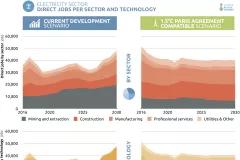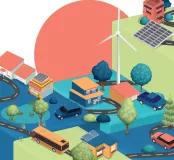Viet Nam, a rapidly developing economy, has pledged to reduce emissions and transition to renewable energy. At COP26, it committed to peaking emissions by 2035 and achieving carbon neutrality by 2050. The electricity sector plays a crucial role in this effort, with renewable energy expected to grow fast and replace fossil energy in the long term.
Viet Nam’s 8th National Power Development Plan for the period 2021-2030, with a vision to 2050 (PDP8), outlines the country’s plans for meeting energy demand and shifting to renewable energy. In 2022, Viet Nam partnered with the International Partners Group through the Just Energy Transition Partnership (JETP) to accelerate its transition to a low-emission energy system. The JETP will mobilise 15.5 billion USD in public and private sector investments over the next three to five years to support Viet Nam's green transition.
Informed by the scenarios outlined in the PDP8 and JETP, this report provides an initial estimate of the projected demand for human resources in Viet Nam’s power sector through to 2050. It uses NewClimate Institute’s Economic Impact Model for Electricity Supply, which estimates the domestic employment impacts of investments in the electricity supply sector based on an input-output model.
Key findings:
- The electricity sector will grow – and with it, the demand for labour. The build-up of the electricity sector with a high share of renewable energy sources under the PDP8 will increase direct labour needs in the power supply and related sectors. Our model estimates an increase from around 300,000 full-time employees (FTE) today to approximately 500,000 FTEs by 2035.
- Jobs related to new coal-fired power plants will quickly decline, while employment in coal mining decrease more gradually, giving time for employment transition planning and retraining. Overall, job creation in renewable energy industries will outweigh job losses, although the locations and types of new jobs are unlikely to fully match those being phased out. As such, industrial diversification may be needed in coal-dependent areas.
- The expansion of renewable energy, particularly solar PV and wind energy, will lead to a surge in labour demand in related industries. By the 2030s, wind and solar technologies are estimated to account for more than half of the direct labor force in the power sector – around 300,000 FTEs.
- Varying local content shares strongly drives labour demand in our model. In the short term, Viet Nam will need to continue importing components and services that the domestic market cannot yet supply. However, through a long-term vision on localising manufacturing and employment, the country can ensure a more stable and predictable labour force demand.
- The JETP scenario will avoid some of the disruptive patterns observed under PDP8. The JETP scenario includes a faster but more gradual build-up of solar and wind technologies, and a more modest increase in gas capacity. This approach helps to prevent most severe fluctuations in the power sector, reducing market volatility that might otherwise deter companies as well as new workers from entering the renewable industry.
The findings highlight the need for fast action aligned to a long-term vision. Training and reskilling programmes for workers, as well as a strategy to increase local content shares in the renewable industries will be key to ensuring a stable and predictable labour force demand.









